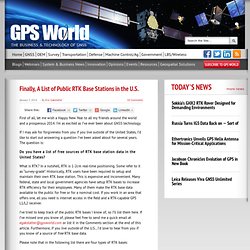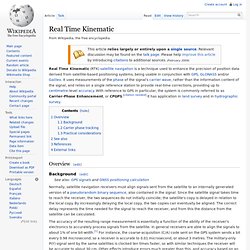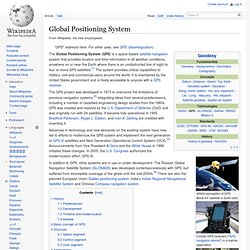

Wireless-extendedrange-wp. Finally, A List of Public RTK Base Stations in the U.S. : GPS World. First of all, let me wish a Happy New Year to all my friends around the world and a prosperous 2014.

I’m as excited as I’ve ever been about GNSS technology. If I may ask for forgiveness from you if you live outside of the United States, I’d like to start out answering a question I’ve been asked about for several years. The question is: Do you have a list of free sources of RTK base station data in the United States? What is RTK? I’ve tried to keep track of the public RTK bases I know of, so I’ll list them here. Please note that in the following list there are four types of RTK bases: Trimble VRS (network solution).Leica Spider (network solution).Single baseline (eg. I’ve used an RTK rover on all three of these services. To use any of the services, you’ll need Internet connectivity. SIM card inside a data collector.MiFi device.Wi-Fi from a work vehicle. You can also use a commercial RTK Bridge or Repeater such as Intuicom or Base-n-ABox. You’ll also need some sort of NTRIP software utility. Real Time Kinematic. Overview[edit] Background[edit] Normally, satellite navigation receivers must align signals sent from the satellite to an internally generated version of a pseudorandom binary sequence, also contained in the signal.

Since the satellite signal takes time to reach the receiver, the two sequences do not initially coincide; the satellite's copy is delayed in relation to the local copy. By increasingly delaying the local copy, the two copies can eventually be aligned. The correct delay represents the time needed for the signal to reach the receiver, and from this the distance from the satellite can be calculated. The accuracy of the resulting range measurement is essentially a function of the ability of the receiver's electronics to accurately process signals from the satellite. Carrier phase tracking[edit] The difficulty in making an RTK system is properly aligning the signals. Practical considerations[edit] See also[edit] References[edit] External links[edit]
Introduction%20to%20Global%20Positioning%20System. Global Positioning System. Artist's conception of GPS Block II-F satellite in Earth orbit.

The Global Positioning System (GPS) is a space-based satellite navigation system that provides location and time information in all weather conditions, anywhere on or near the Earth where there is an unobstructed line of sight to four or more GPS satellites.[1] The system provides critical capabilities to military, civil and commercial users around the world. It is maintained by the United States government and is freely accessible to anyone with a GPS receiver. The GPS project was developed in 1973 to overcome the limitations of previous navigation systems,[2] integrating ideas from several predecessors, including a number of classified engineering design studies from the 1960s. GPS was created and realized by the U.S. Department of Defense (DoD) and was originally run with 24 satellites. History[edit] Predecessors[edit] Official logo for NAVSTAR GPS Development[edit] Timeline and modernization[edit]